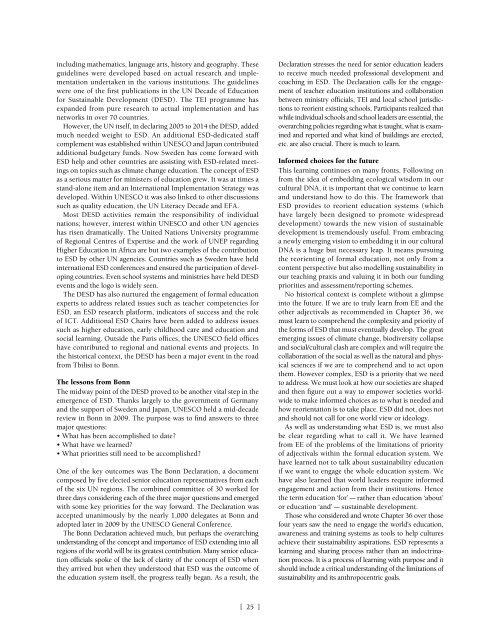Tomorrow today; 2010 - unesdoc - Unesco
Tomorrow today; 2010 - unesdoc - Unesco
Tomorrow today; 2010 - unesdoc - Unesco
You also want an ePaper? Increase the reach of your titles
YUMPU automatically turns print PDFs into web optimized ePapers that Google loves.
including mathematics, language arts, history and geography. Theseguidelines were developed based on actual research and implementationundertaken in the various institutions. The guidelineswere one of the first publications in the UN Decade of Educationfor Sustainable Development (DESD). The TEI programme hasexpanded from pure research to actual implementation and hasnetworks in over 70 countries.However, the UN itself, in declaring 2005 to 2014 the DESD, addedmuch needed weight to ESD. An additional ESD-dedicated staffcomplement was established within UNESCO and Japan contributedadditional budgetary funds. Now Sweden has come forward withESD help and other countries are assisting with ESD-related meetingson topics such as climate change education. The concept of ESDas a serious matter for ministers of education grew. It was at times astand-alone item and an International Implementation Strategy wasdeveloped. Within UNESCO it was also linked to other discussionssuch as quality education, the UN Literacy Decade and EFA.Most DESD activities remain the responsibility of individualnations; however, interest within UNESCO and other UN agencieshas risen dramatically. The United Nations University programmeof Regional Centres of Expertise and the work of UNEP regardingHigher Education in Africa are but two examples of the contributionto ESD by other UN agencies. Countries such as Sweden have heldinternational ESD conferences and ensured the participation of developingcountries. Even school systems and ministries have held DESDevents and the logo is widely seen.The DESD has also nurtured the engagement of formal educationexperts to address related issues such as teacher competencies forESD, an ESD research platform, indicators of success and the roleof ICT. Additional ESD Chairs have been added to address issuessuch as higher education, early childhood care and education andsocial learning. Outside the Paris offices, the UNESCO field officeshave contributed to regional and national events and projects. Inthe historical context, the DESD has been a major event in the roadfrom Tbilisi to Bonn.The lessons from BonnThe midway point of the DESD proved to be another vital step in theemergence of ESD. Thanks largely to the government of Germanyand the support of Sweden and Japan, UNESCO held a mid-decadereview in Bonn in 2009. The purpose was to find answers to threemajor questions:• What has been accomplished to date?• What have we learned?• What priorities still need to be accomplished?One of the key outcomes was The Bonn Declaration, a documentcomposed by five elected senior education representatives from eachof the six UN regions. The combined committee of 30 worked forthree days considering each of the three major questions and emergedwith some key priorities for the way forward. The Declaration wasaccepted unanimously by the nearly 1,000 delegates at Bonn andadopted later in 2009 by the UNESCO General Conference.The Bonn Declaration achieved much, but perhaps the overarchingunderstanding of the concept and importance of ESD extending into allregions of the world will be its greatest contribution. Many senior educationofficials spoke of the lack of clarity of the concept of ESD whenthey arrived but when they understood that ESD was the outcome ofthe education system itself, the progress really began. As a result, theDeclaration stresses the need for senior education leadersto receive much needed professional development andcoaching in ESD. The Declaration calls for the engagementof teacher education institutions and collaborationbetween ministry officials, TEI and local school jurisdictionsto reorient existing schools. Participants realized thatwhile individual schools and school leaders are essential, theoverarching policies regarding what is taught, what is examinedand reported and what kind of buildings are erected,etc. are also crucial. There is much to learn.Informed choices for the futureThis learning continues on many fronts. Following onfrom the idea of embedding ecological wisdom in ourcultural DNA, it is important that we continue to learnand understand how to do this. The framework thatESD provides to reorient education systems (whichhave largely been designed to promote widespreaddevelopment) towards the new vision of sustainabledevelopment is tremendously useful. From embracinga newly emerging vision to embedding it in our culturalDNA is a huge but necessary leap. It means pursuingthe reorienting of formal education, not only from acontent perspective but also modelling sustainability inour teaching praxis and valuing it in both our fundingpriorities and assessment/reporting schemes.No historical context is complete without a glimpseinto the future. If we are to truly learn from EE and theother adjectivals as recommended in Chapter 36, wemust learn to comprehend the complexity and priority ofthe forms of ESD that must eventually develop. The greatemerging issues of climate change, biodiversity collapseand social/cultural clash are complex and will require thecollaboration of the social as well as the natural and physicalsciences if we are to comprehend and to act uponthem. However complex, ESD is a priority that we needto address. We must look at how our societies are shapedand then figure out a way to empower societies worldwideto make informed choices as to what is needed andhow reorientation is to take place. ESD did not, does notand should not call for one world view or ideology.As well as understanding what ESD is, we must alsobe clear regarding what to call it. We have learnedfrom EE of the problems of the limitations of priorityof adjectivals within the formal education system. Wehave learned not to talk about sustainability educationif we want to engage the whole education system. Wehave also learned that world leaders require informedengagement and action from their institutions. Hencethe term education ‘for’ – rather than education ‘about’or education ‘and’ – sustainable development.Those who considered and wrote Chapter 36 over thosefour years saw the need to engage the world’s education,awareness and training systems as tools to help culturesachieve their sustainability aspirations. ESD represents alearning and sharing process rather than an indoctrinationprocess. It is a process of learning with purpose and itshould include a critical understanding of the limitations ofsustainability and its anthropocentric goals.[ 25 ]

















